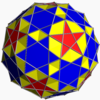Igor Pak's answer suggests that conjugate polyhedra in the sense of the question should be different realizations of the same abstract polyhedron (defined by a face lattice); so in this answer I'll list those which are abstractly isomorphic. The two main references for this answer are the paper "Closed-Form Expressions for Uniform Polyhedra and Their Duals" by Peter Messer and the page "Polytopes & their Incidence Matrices" by Richard Klitzing.
Abstract isomorphism
(In earlier revisions of this answer I attempted to say something about abstract isomorphism from the table of vertex cycle symbols in Messer's paper, but as I wasn't able to get very far with that approach, I've deleted it. The first two comments to this answer refer to that text.)
Klitzing's site seems to be unique in that the subpages indicate which sets of polyhedra are abstractly isomorphic, but it's unfortunately a bit tricky to navigate (I could not find an easy to parse list of just the 75 non-prismatic uniform polytopes; the closest was this). With Wikipedia's list of uniform polyhedra, I managed to find each of the polyhedra on his site by googling their names with the keyword "site:bendwavy.org".
Here's a summary:
The conjugate groupings of uniform polyhedra in Tito Pieza III's list correspond to abstract isomorphism classes of uniform polyhedra except that:
- 23 ($U_{46}$) is actually abstractly isomorphic to $U_{64}$,
- $U_{30}$ and $U_{47}$ are abstractly isomorphic, but not on the list of conjugates,
- $U_{62}$ and $U_{65}$ are also abstractly isomorphic and not on the list of conjugates,
- and finally, 22 ($U_{12}$) is in an abstract isomorphism class on its own, as are $U_n$ with $n=1, 2,3,4,5,6,7,8,15,16,36,38,41,44,45,56,59,62,65,75$ (the same list as in his comment on that answer, except that 30, 47, 62, 64, 65 are omitted, per above).
(Here's the text document I compiled while searching Klitzing's site that includes the names of the polyhedra in nonsingleton abstract isomorphism classes and links.)
edit: Klitzing claims on his pages (as of 18 Feb 2021) that $U_{33},U_{61},U_{43},U_{42}$ are all abstractly isomorphic (see for example this archive link). In earlier versions of this answer, I repeated that claim here, stating that the two conjugate groupings 13 ($U_{42}$ and $U_{43}$) and 14 ($U_{33}$ and $U_{61}$) formed one abstract isomorphism class. However, Daniel Sebald pointed out in a comment on this answer that this isn't true; the 1-skeleta of $U_{33}$ and $U_{61}$ contain squares and those of $U_{42}$ and $U_{43}$ do not!
Circumradii
To get from this to the squared circumradii, the results in the paper cited in Igor Pak's answer state that the squared circumradii of two abstractly isomorphic polyhedra should be roots of the same polynomial (actually we require some generalization of those theorems to non-simplicial polyhedra, which might be straightforward).
One thing to keep in mind is that the polynomial equations satisfied by general polynomial invariants (in the sense of Fedorchuk and Pak's paper) could be reducible. So their results alone are not sufficient to show that circumradii of uniform polyhedra that are abstractly isomorphic are actually Galois conjugate.
Indeed, the fact that the abstract isomorphism classes above don't all correspond to the Galois conjugacy classes found previously bear this out!
This is of course a good conceptual framework to think about what's going on, but a more hands-on approach is also possible:
Messer gives explicit expressions for the circumradii in his paper; in section 8, the circumradius ${}_{0}R$ is expressed as $\csc\phi$, where $\phi$ is the angle subtended by a half-edge when viewed from the center of the circumsphere. In section 9, he gives expressions for $\cot\phi$ for the uniform polyhedra for the first 3 of the 4 "forms" mentioned in Tito Pieza III's answer. Appendix A contains polynomials that define $Y=2-\tan^2\phi$ for the fourth "snub" case, and in fact the table given there places the Wythoff symbols together when their $Y$ satisfy the same polynomial. In each case, it should be possible to check the conjugacy from these expressions (after applying some trigonometric identities and rewriting certain cosines of rational multiples of $\pi$ as roots of polynomials).


